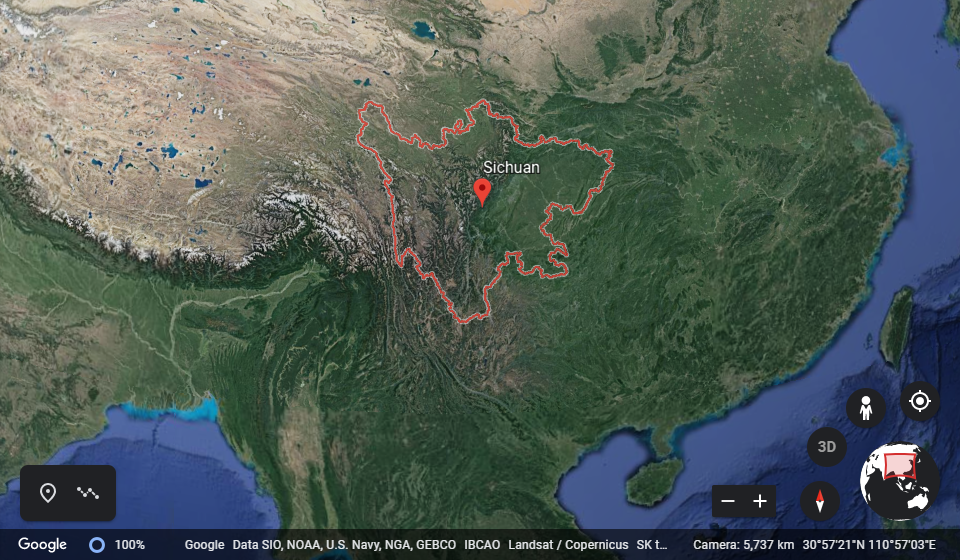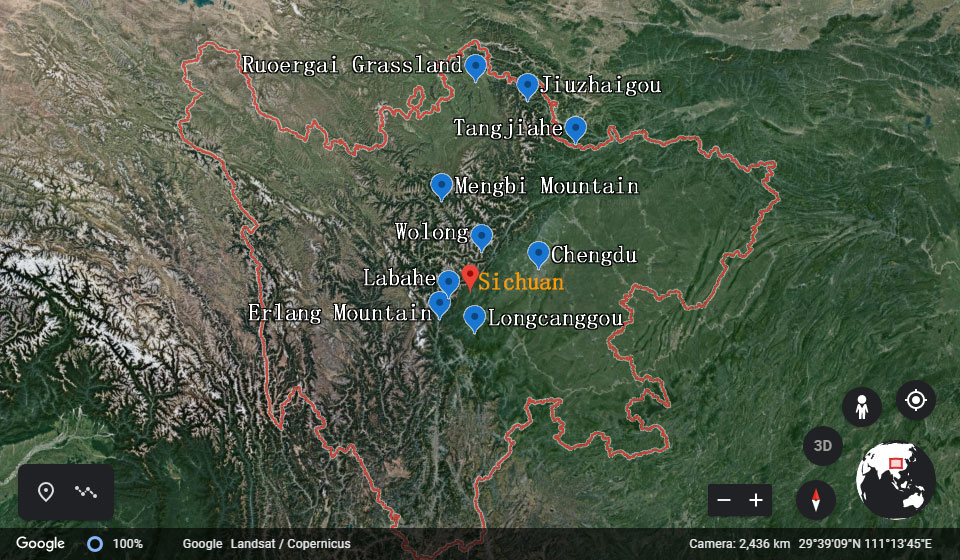Birding Info of Sichuan, China

Located in the west of China and the upper reaches of the Yangtze River, Sichuan is an inland province of China covering 486,000 square kilometers with over 90 million people. The province mainly consists of three parts, Sichuan Basin in the middle and east, Qinghai Tibet-Plateau in the west, and hilly areas in the south. Qinghai-Tibet Plateau and Hengduan Mountain Ranges stand in its west. Yunnan-Guizhou Plateau in the south and Qinling-Daba Mountain Ranges in the north.
The elevation varies from 500 meters to 7,514 meters above sea level. Being endowed with various landforms, Sichuan enjoys many different climate conditions. The Basin has a subtropical humid climate while the plateaus and mountains have perpendicular changed weather with long cold winter.
Besides, Sichuan has abundant water resources with more than 1,400 rivers and 1,000 lakes. The province is also the largest water resource holding area of the upper reaches of the Yangtze River.
The diversified topography and climate of Sichuan Province have made it a home for a large number of rare species. According to the investigates, about 750 bird species have been recorded here. Sichuan is the kingdom of Pheasants of which 23 species are under Galliformes accounting for 35% of the total species in China. Among all these pheasant species, there are 10 species endemic to China. There are many fascinating birding sites such as Emei Shan/ Emei Mountain, Jiuzhaigou Valley National Park, Longcanggou, Balang Shan/Balang Mountain, Tangajiahe Nature Reserve, Erlang Mountain, Mengbi Mountain, Wawu Mountain Forest Park, Ruoergai, Baxi Forest, Wild Flower Lake, Baihe Nature Reserve, Laojun Mountain, etc.
Additionally, Sichuan is well known as a shelter for Giant Panda (Ailuropoda melanoleuca), Chinese Dove Tree (Davidia involucrata), and many other relic species. There are 146 animal species under national key protection including some incredible species such as Giant Panda, Golden Snub-nosed Monkey, Asiatic Black Bear, Sichuan Takin, Chinese Mountain Cat, etc.
Moreover, Sichuan is known widely as the “heaven of good food”, the diverse fiery dishes have made Sichuan Cuisine famous worldwide. Explore Chengdu, the capital of Sichuan Province which has a history of over 3000 years and try some local food is also a nice choice.
Some Important Birding Sites in Sichuan


Wolong Nature Reserve (Balang Shan/ Balang Mountain)
Located in Wenchuan County, Aba Tibetan, and Qiang Autonomous Prefecture and covering 200,000 hectares, the reserve was established in 1963 and upgraded to a national reserve in 1990. The reserve has abundant both botanical and animal resources with about 4000 plant species and over 300 bird species. The reserve consists of a huge area that covers Balang Mountain Pass, tunnel area, Wuyipeng Research Station, Lama Monastery, Wolong Shenshuping Panda Base, etc.
Wolong is the best place for pheasants such as Golden Pheasant, Temminck's Tragopan, Tibetan Snowcock, Chinese Monal, White-eared Pheasant, Verreaux's Partridge, Blood Pheasant, Koklass Pheasant. Other species can be found here including Lammergeier, Firethroat (May&June), Eurasian Sparrowhawk, Chinese Fulvetta, Chinese Rubythroat, Golden Bush-Robin, Streaked Rosefinch, Dark-breasted Rosefinch, Dark-rumped Rosefinch, Crimson-browed Finch, Common Rosefinch, Kessler's Thrush (White-backed Thrush), Rufous-vented Tit, Sichuan Tit, Asian House-Martin, Alpine Leaf Warbler, Giant Laughingthrush, White-throated Redstart, Bearded Vulture, Golden Eagle, Red, and Yellow-billed Chough, Alpine Accentor, Brandt’s Mountain Finch, Snow Pigeon, Red-fronted Rosefinch, Rosy Pipit, etc.
Tangjiahe Nature Reserve
Established in 1978 and upgraded to a national reserve in 1986, Tangjiahe Nature Reserve covers an area of 40,000 hectares with the main goal to protect Giant Panda and other rare animals including Golden Snub-nosed Monkey, Sichuan Takin, Tibetan Macaque, Reeves’ Muntjac, Asian Wild Boar, Chinese Goral, Hog Badger, Leopard Cat, Serow, Yellow-throated Marten, Tufted Deer, Asian Black Bear, etc.
About 2,422 plant species and over 200 bird species have been recorded. Birding here can be very exciting as you can expect Golden Pheasant, Speckled Wood-Pigeon, Asian Koel, Large Hawk-Cuckoo, Himalayan Cuckoo, Pacific Swift, Grey-capped Woodpecker, White-backed Woodpecker, Great Spotted Woodpecker, Crimson-breasted Woodpecker, Mountain Bulbul, Spectacled Fulvetta, Pygmy Cupwing, Yellow-bellied Tit, Sooty Bushtit, White-collared Yuhina, Slaty Bunting, Grey-headed Canary-flycatcher, Sichuan Leaf Warbler, Bianchi's Warbler, Martens's Warbler, Large-billed Leaf Warbler, Sulphur-breasted Warbler, Rufous-faced Warbler, Chestnut-crowned Warbler, Brown Dipper, Plumbeous Redstart, White-capped Redstart, Crested Kingfisher, White-crowned Forktail, Little Forktail, Blue Rock Thrush, etc. There is a chance to find the spectacular Tawny Fish Owl, but it really requires a good amount of work and some luck.
Jiuzhaigou Nature Reserve
Located in Aba Tibetan and Qiang Autonomous Prefecture northwest of Sichuan, the reserve was established in 1987 and upgraded national reserve in 1994. Covering 65,074 hectares, the reserve aims to protect Giant Panda, Golden Snub-nosed Monkey, and the habitats they depend on. According to statistics, there are more than 250 bird species have been recorded in the reserve, including the most famous one Rufous-headed Robin, and other birds like Blood Pheasant, Blue Eared-Pheasant, Yellow-bellied Tit, Pere David's Tit, Chinese Leaf Warbler, Sichuan Leaf Warbler, Yellow-streaked Warbler, Spectacled Parrotbill, Elliot's Laughingthrush, Przevalski's Nuthatch, Sichuan Treecreeper, etc.
Ruoergai Grassland (Flower Lake & Baxi Forest)
Ruoergai, a vast plain of the Tibetan Plateau known as the ‘lungs of Sichuan’. The main habitats are grassland but there are also virgin forests. It is a tip to spend morning time in the mountain with virgin forests at the edge of the plateau provide that good habitat for forest birds such as the rare Chinese Grouse, Blue Eared Pheasant, Sichuan Jay, the elusive Black Woodpecker, Przevalski's Nuthatch, Snowy-browed Nuthatch, Plain Laughingthrush (Pere David's Laughingthrush), Snowy-cheeked Laughingthrush (Sukatschev's Laughingthrush), Giant Laughingthrush, Elliot's Laughingthrush, Sichuan Tit, White-browed Tit Warbler, Crested Tit-Warbler, Chinese Leaf Warbler, Sichuan Leaf Warbler, Yellow-streaked Warbler, Chinese Fulvetta, Slaty-backed Flycatcher, Spectacled Parrotbill, White-throated Redstart, Hodgson's Redstart, Black Redstart, Common Rosefinch, Common Crossbill, Godlewski's Bunting, etc.
While you can spend the afternoon at Flower Lake. As one of the most important plateau wetlands in China, it attracts many migrant birds breeding in the summertime which include the elegant Black-necked Crane, Greylag Goose, Great Crested Grebe, Slavonian Grebe, Black-necked Grebe, Tufted Duck, Red-crested Pochard, Common Pochard, Ferruginous Duck, Gadwall, Mallard, Ruddy Shelduck, Brown-headed Gull, White-winged Black Tern, Whiskered Tern, Black Stork, Great Bittern, Grey Heron, Purple Heron, Chinese Pond Heron, Lesser Sand Plover, Common Redshank, Wood Sandpiper, Citrine Wagtail, Little Ringed Plover, etc. Some difficult species like Whooper Swan and Bar-headed Goose are occasionally spotted from distance.
On the grassland, you can look for White-rumped Snowfinch, Rufous-necked Snowfinch, Oriental Skylark, Tibetan Lark, Horned Lark, Saker Falcon, Lammergeier (Bearded Vulture), Himalayan Vulture, Upland Buzzard, Common Kestrel.
Mengbi Mountain
Standing between Xiaojin County and Maerkang, Mengbi Mountain holds significant differences in elevations along with well-protected virgin forest, abundant flowers, and few people have made this site a paradise for birds, including endemic birds like Chestnut-throated Monal Partridge (Verreaux’s Partridge), the rare Sichuan Jay. Other fascinating birds indeed including Blood Pheasant, Crested Tit Warbler, Chinese Fulvetta, the range-limited Crimson-browed Finch, Three-banded Rosefinch, Pink-rumped Rosefinch, Streaked Rosefinch, White-throated Needletail, Golden Eagle, Eurasian Sparrowhawk, Himalayan Buzzard, Long-tailed Thrush, Przevalski’s Nuthatch, Goldcrest, Rufous-vented Tit, Grey Crested Tit, Hodgson’s Treecreeper, White-winged Grosbeak, Spotted Nutcracker, Grey-headed Bullfinch Hume's Warbler, Sichuan Leaf Warbler, Buff-barred Warbler, Collared Grosbeak, White-winged Grosbeak, Red Crossbill, etc.
It is worthwhile to keep an eye on the plateau mammals, the adorable Plateau Pika normally emerge from their nests and graze on the grassland, while the Himalayan Marmot tugging hug the ground. Other sought-after mammals you may well see include Tibetan Fox, Red Fox, Hog Badger, Tufted Deer, and the scarce Grey Wolf, Chinese Mountain Cat, and Tibetan Roe Deer.
Labahe Nature Reserve
Lying deep in the Hengduan mountain range, a significant wild panda habitat, Labahe is by far one of the best locations in China to see Red Panda. The mixed alpine forests and dense bamboo understory make an ideal habitat for the Red Panda, though it will still require a good amount of hard work and patience to find one. In addition, Labahe is a very good birding site. There is a big variety of interesting species including Lady Amherst's Pheasant, Temminck's Tragopan, Brown Parrotbill, Fulvous Parrotbill, Sichuan Treecreeper, Speckled Wood-Pigeon, Spotted Nutcracker, Yellow-browed Tit, Fire-capped Tit, Coal Tit, Pere David's Tit, Black-browed Tit, Brown Bush Warbler, Aberrant Bush Warbler, Yellowish-bellied Bush Warbler, Chinese Cupwing, Pygmy Cupwing, Ashy-throated Warbler, Sichuan Leaf Warbler, Grey-hooded Fulvetta, Golden-breasted Fulvetta, Stripe-throated Yuhina, Black-faced Laughingthrush, Rufous-gorgeted Flycatcher, Golden Bush-Robin, etc.
Erlang Mountain
Erlang Mountain is the first high mountain that can be seen from the national road running from Chengdu to Lhasa. The completion of the Erlang Mountain tunnel has transformed the busy old road to the mountain pass an ideal birding route. The dense forest is a perfect habitat for the elegant Lady Amherst's Pheasant, brilliant Firethroat, and endemic Rufous-tailed Babbler. Besides, there are many sought after species such as Lesser Cuckoo, Eurasian Jay, Yellow-bellied Tit, Buff-throated Warbler, Grey-crowned Warbler, Greenish Warbler, White-browed Fulvetta, Spot-breasted Parrotbill, Brown Parrotbill, Streak-breasted Scimitar-Babbler, Black-streaked Scimitar-Babbler, Chinese Babax, Black-faced Laughingthrush, Streaked Barwing, Chinese Thrush, White-tailed Robin, Golden Bush-Robin, Mrs. Gould's Sunbird, White-winged Grosbeak, Dark-rumped Rosefinch, Sharpe's Rosefinch, Vinaceous Rosefinch, Yellow-throated Bunting, etc.
Longcanggou National Forest Park
Located on the western edge of the Sichuan basin, Longcanggou is in the core area of the transition zone between the basin and Qinghai-Tibet Plateau. The special location makes the geological structures here very diverse. One of the densest subtropical evergreen broad-leaved forests is found here and is home to a lot of range-restricted and endemic species including Temminck's Tragopan, Lady Amherst's Pheasant, Great Parrotbill, Brown Parrotbill, Three-toed Parrotbill, Grey-hooded Parrotbill, Golden Parrotbill, Grey-hooded Fulvetta, Golden-breasted Fulvetta, Red-winged Laughingthruhrush, Spotted Laughingthrush, Black-faced Laughingthrush, Darjeeling Woodpecker, Vinaceous Rosefinch, White-throated Needletail, Coal Tit, Fire-capped Tit, Ashy-throated Warbler, Sichuan Leaf Warbler, Emei Leaf Warbler, Large-billed Leaf Warbler, Yellowish-bellied Bush Warbler, Aberrant Bush Warbler, etc. In the broadleaf forest of lower elevation, we will look for Gold-fronted Fulvetta, David's Fulvetta, Crimson-breasted Woodpecker, Speckled Piculet, Yellow-browed Tit, Yellow-bellied Tit, Black-throated Tit, Sichuan Bush Warbler, Pygmy Cupwing, Black Bulbul, Emei Leaf Warbler, Chestnut-crowned Warbler, Brownish-flanked Bush Warbler, Rufous-capped Babbler, Red-billed Leiothrix, Red-tailed Minla, Blue-winged Minla, Ferruginous Flycatcher, Snowy-browed Flycatcher, Taiga Flycatcher, Brown Bullfinch, etc.
Last one: The First
Next one: Birding info of Anhui, China







